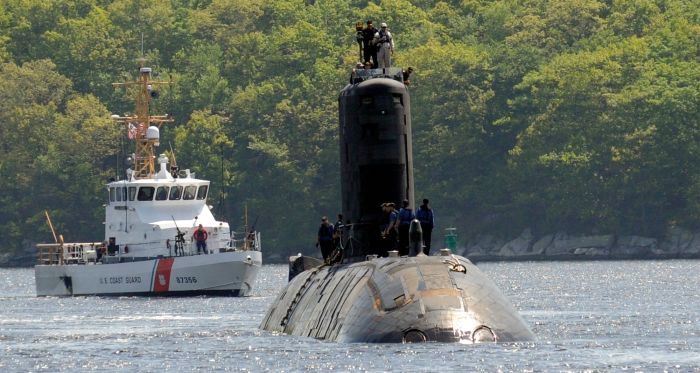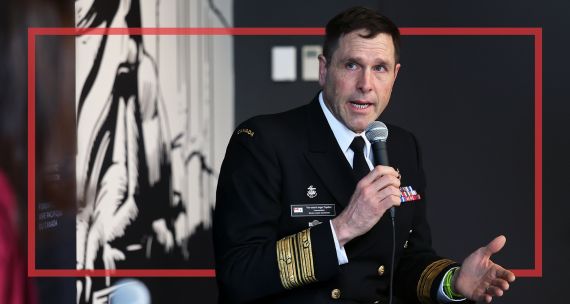Climate change has opened up the waters of the Canadian Arctic, increasing the region’s strategic importance and presenting new security challenges from powers such as China and Russia. Canada’s vast and vulnerable Arctic coastline necessitates a submarine fleet capable of prolonged and stealthy under-ice operations to deter potential adversaries. These operations are critical for addressing threats that originate within the Canadian Arctic, transit through the region, or directly involve the Arctic, such as potential incursions by foreign naval forces or unauthorized resource exploitation. The Victoria-class submarines, purchased from the U.K. government in the 1990s, have proven inadequate for Arctic operations, frequently spending more time in dry dock than on missions.
A New Defence Strategy and Modernizing the Fleet
In April 2024, Canadian Prime Minister Justin Trudeau unveiled “Our North, Strong and Free,” a comprehensive defence policy update (DPU) that emphasizes modernizing the Royal Canadian Navy’s underwater capabilities as part of a broader strategy to strengthen national security and address evolving challenges. As part of the DPU, Canada announced plans to invest C$60 billion to replace its aging submarines with up to 12 advanced, conventionally powered vessels designed for Arctic conditions, with the first replacement submarine to be delivered no later than 2035. Conversations about the potential acquisition of nuclear-powered submarines have resurfaced, although these discussions remain in the exploratory phase, with no formal commitment thus far from either the government or the military.
Canada’s Long-running Nuclear Submarine Debate
Canada’s interest in nuclear submarines dates back to 1987 — and in fact even as far back as the late 1950s — when Canada announced plans to transition from German-style diesel submarines to a fleet of 10-12 nuclear submarines, surprising non-proliferation advocates. That announcement nearly led to supply contracts with the U.K. and France. However, under pressure from the U.S., which feared the market-driven expansion of nuclear technology, Canada abandoned these plans. Historically, the U.S. has been wary of Canada’s nuclear submarine ambitions due to potential operational and strategic complications.
Today, opinions within Canada on acquiring nuclear submarines remain sharply divided. Proponents highlight the strategic advantages, such as these submarines’ long-range capabilities and ability to engage in extended Arctic operations — attributes that would enhance Canada’s role within NATO and strengthen its defence posture alongside key allies like the U.S. Critics, however, argue against nuclear submarines due to their high costs, logistical challenges, complex maintenance, potential safety and environmental risks, and the challenge of training crews to operate them. They argue that advanced conventional submarines are sufficient for meeting Canada’s needs without the complexities associated with nuclear propulsion. These mixed responses reflect the broader debate over the best path forward for Canada’s submarine fleet, balancing strategic imperatives with practical considerations.
The discussion around nuclear submarines in Canada has become more nuanced, particularly in light of Australia’s inclusion in AUKUS — a security pact between Australia, the U.K., and the U.S. — which allows Canberra to acquire nuclear submarines to counter Chinese expansion in the Indo-Pacific. This development has sparked discussions in Canada about whether a similar path might be feasible. However, Australia’s acquisition of nuclear submarines through AUKUS, which has been backed by the U.S., positions Australia as the sole exception in an otherwise restrictive U.S. naval defence policy. While countries like Canada and South Korea have shown interest in nuclear submarines, the U.S. consistently sees Australia’s nuclear fleet as sufficient in meeting regional security needs, potentially leaving Canada at a strategic disadvantage.
A Pragmatic and Strategic Approach to Conventional Submarines
The cold depths of the Arctic Ocean have long been a stage for geopolitical manoeuvring, where submarines play a crucial role in national defence strategies, including in intelligence gathering, deterrence, and protecting maritime territory. For Canada, modernizing the fleet is essential for addressing both current and future defence challenges and maintaining a strategic edge in these increasingly contested waters.
In April 2024, at a news conference for the government’s updated defence policy, Trudeau did not rule out considering nuclear-powered submarines, stating: “That is certainly what we will be looking at as to what type of submarines are most appropriate for Canada’s responsibility and protecting the longest coastline in the world.” This comment, which could be read as Canada being open to the nuclear submarine option, came as a surprise, as officials had briefed journalists just hours earlier about Canada focusing solely on conventional submarines.
Presently, the Royal Canadian Navy appears to be steering toward conventionally powered submarines. Canadian defence officials have focused on preliminary research and feasibility studies with government and corporate representatives from France, South Korea, Spain, and Sweden, along with additional dialogues with government officials from Germany and Norway. The September issuance of a Request for Information to submarine builders in these countries further emphasizes Canada’s focus on conventional models, seeking data on their availability, industry capacity to deliver up to 12 submarines within tight timelines, and potential support for long-term maintenance and upgrades.

This reflects a pragmatic decision, considering the high costs, complexities, and diplomatic hurdles associated with nuclear submarines. Conventional submarines, despite their limitations in terms of range and refuelling, are better suited for Canada’s defence needs. Their proven effectiveness in U.S.-led naval exercises and in conflicts such as the 1982 Falklands War highlights their resilience and strategic utility.
This track record of conventional submarines suggests their continued relevance in modern naval strategy, which is why countries such as South Korea and Japan are actively promoting their conventional submarines as ideal for Canada. South Korea’s second batch of KSS-III and Japan’s Taigei-class submarines incorporate key technologies for Arctic operations, such as air-independent propulsion systems and lithium-ion batteries, which offer higher power density, longer operational periods, and enhanced underwater endurance and silence. These features, along with robust ice-breaking capabilities, are crucial for Canada’s strategic needs.
Weighing Geopolitical and Strategic Considerations
In selecting a supplier for its new submarines, Canada must weigh not only the technical capabilities and costs but also the geopolitical consequences of its decision. The decision involves navigating complex relationships, long-term defence goals, and the potential impact on Canada’s role within global alliances.
The geopolitical implications of foreign-made submarines in Canada also warrant careful consideration. For instance, Saab’s C71 ‘Expeditionary’ submarines from Sweden offer a unique blend of operational flexibility and advanced technology, designed specifically to navigate the challenges of extended Arctic operations. France and Spain might offer tailored conventional submarine models that are more adaptable in size and operational scope. The 212CD class, jointly developed by Germany and Norway, emerges as an appealing option, particularly in light of Canada’s recent discussions with these two countries regarding Arctic security. This model combines Germany’s reputation for reliability and technological advancement with Norway’s expertise in Arctic operations.
In addition to potential cost overruns, when Canada selects a supplier, there will be concerns about how much each contender’s offer could contribute to Canada’s defence industry and economy, as well as whether the submarines could operate over long distances and extended periods and be delivered within Canada’s tight timelines and with a guarantee of sustainable maintenance support. Moreover, the selection process is inherently political, with interoperability with U.S. forces a critical factor due to the close military relationship between Canada and the U.S. This highlights the importance of Canada making decisions that not only fulfill its strategic goals and timelines, but also take into account long-term geopolitical relationships, the unique operational demands of Arctic missions, and which country would be the most suitable partner for this critical submarine procurement.
Looking Forward
While Canada’s immediate focus on conventional submarines is pragmatic for addressing current threats, the long-term goal should include building the advanced skills and capabilities needed to eventually adopt more sophisticated submarine technologies, including nuclear-powered submarines. This approach would better position Canada to address evolving security challenges in the Arctic and beyond. Strengthening security co-operation with like-minded countries and jointly pursuing advanced submarine technologies, including nuclear options, should be considered a long-term goal. Additionally, Canada might find it easier to navigate diplomatic challenges, especially U.S. opposition to Canada’s procurement of nuclear submarines, by collaborating closely with its allies.
In other words, rather than focusing solely on immediate acquisition, the procurement process should aim to gradually achieve the long-term objective of acquiring advanced submarines. More importantly, regardless of whether a submarine is nuclear or conventional, its detection and underwater capabilities are relatively limited compared to the size of the operational area. Therefore, other alternative forces should be supplemented. For anti-submarine operations, maritime patrol aircraft, anti-submarine helicopters, and destroyers can often be more effective than submarines. The adoption of advanced submarines should be pursued alongside the accumulation of comprehensive operational capabilities, technological proficiency, and diplomatic leverage so that the opportunity can be seized immediately when it arises.
As Canada evaluates its options, the competition and co-operation from Australia, Japan, South Korea, the U.K., the U.S., and Europe highlight the geopolitical and industrial stakes involved. Each potential partner offers distinct advantages and challenges, requiring a careful assessment of strategic, economic, and technological factors to ensure Canada’s new fleet meets its future defence needs. Balancing international collaboration will be key. A modernized submarine fleet is not just a defence priority for Canada — it is essential to maintaining its status as a key player in Arctic and global maritime security.
• Edited by Vina Nadjibulla, Vice-President Research & Strategy, and Ted Fraser, Senior Editor, APF Canada





